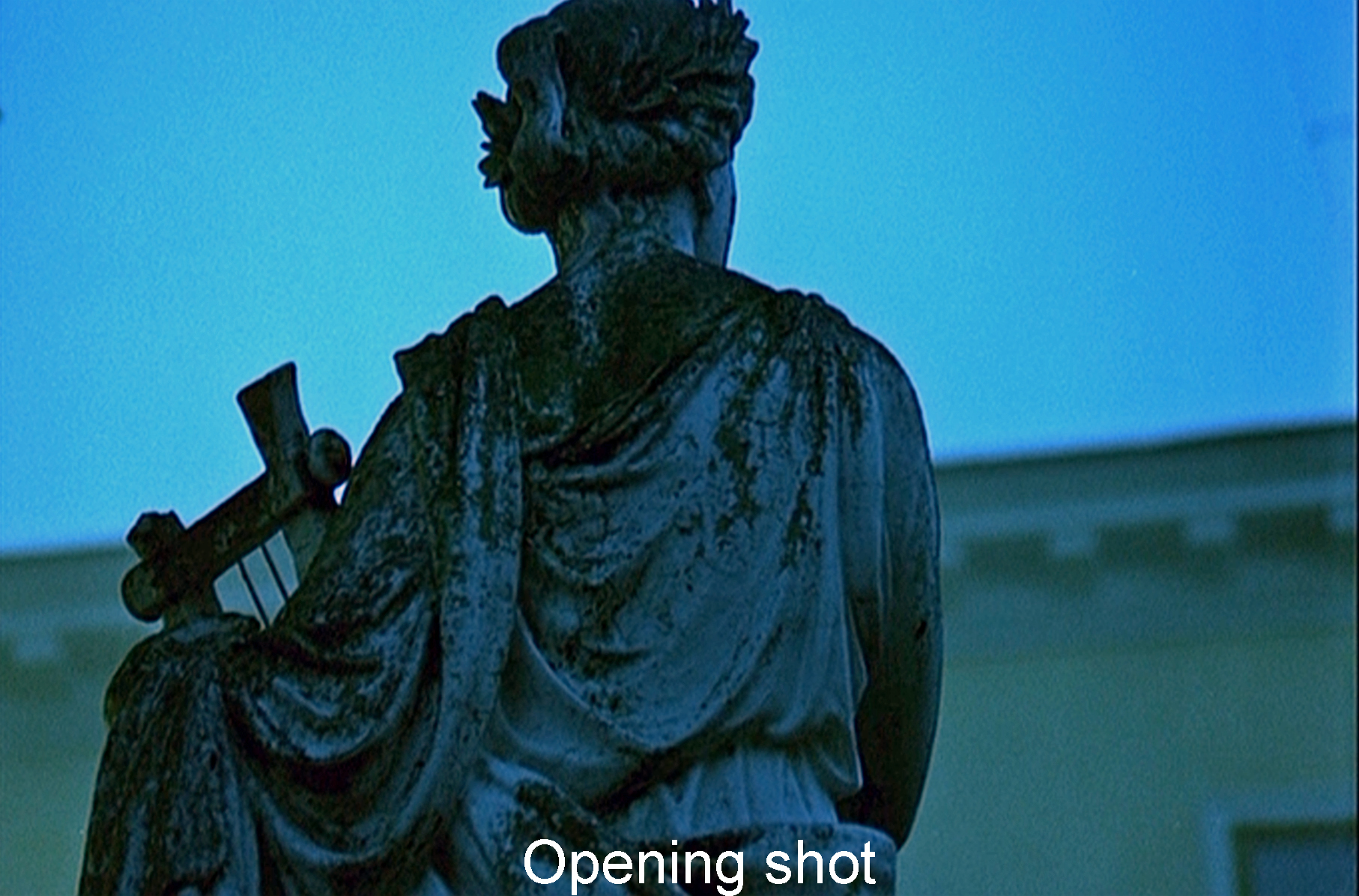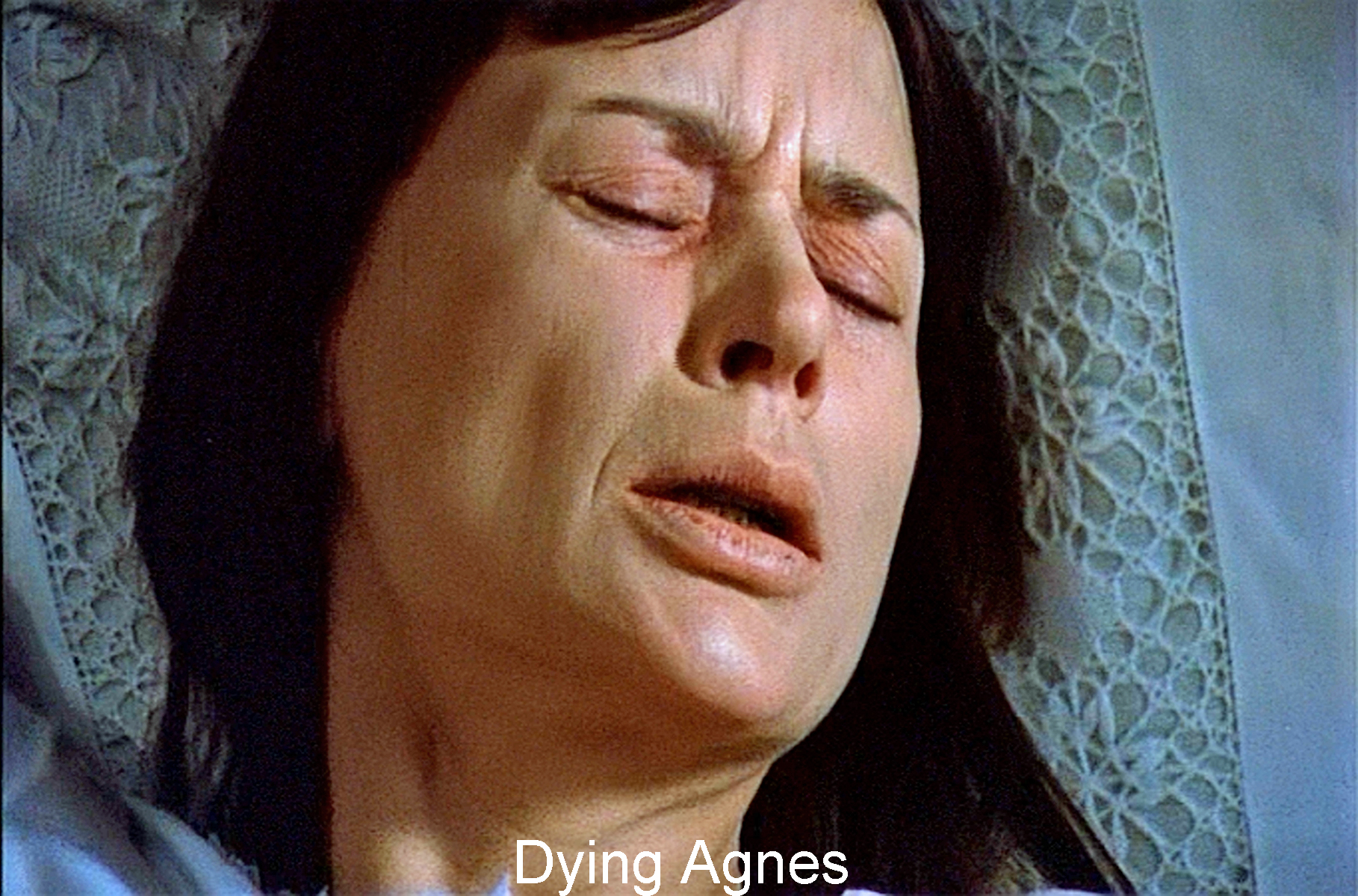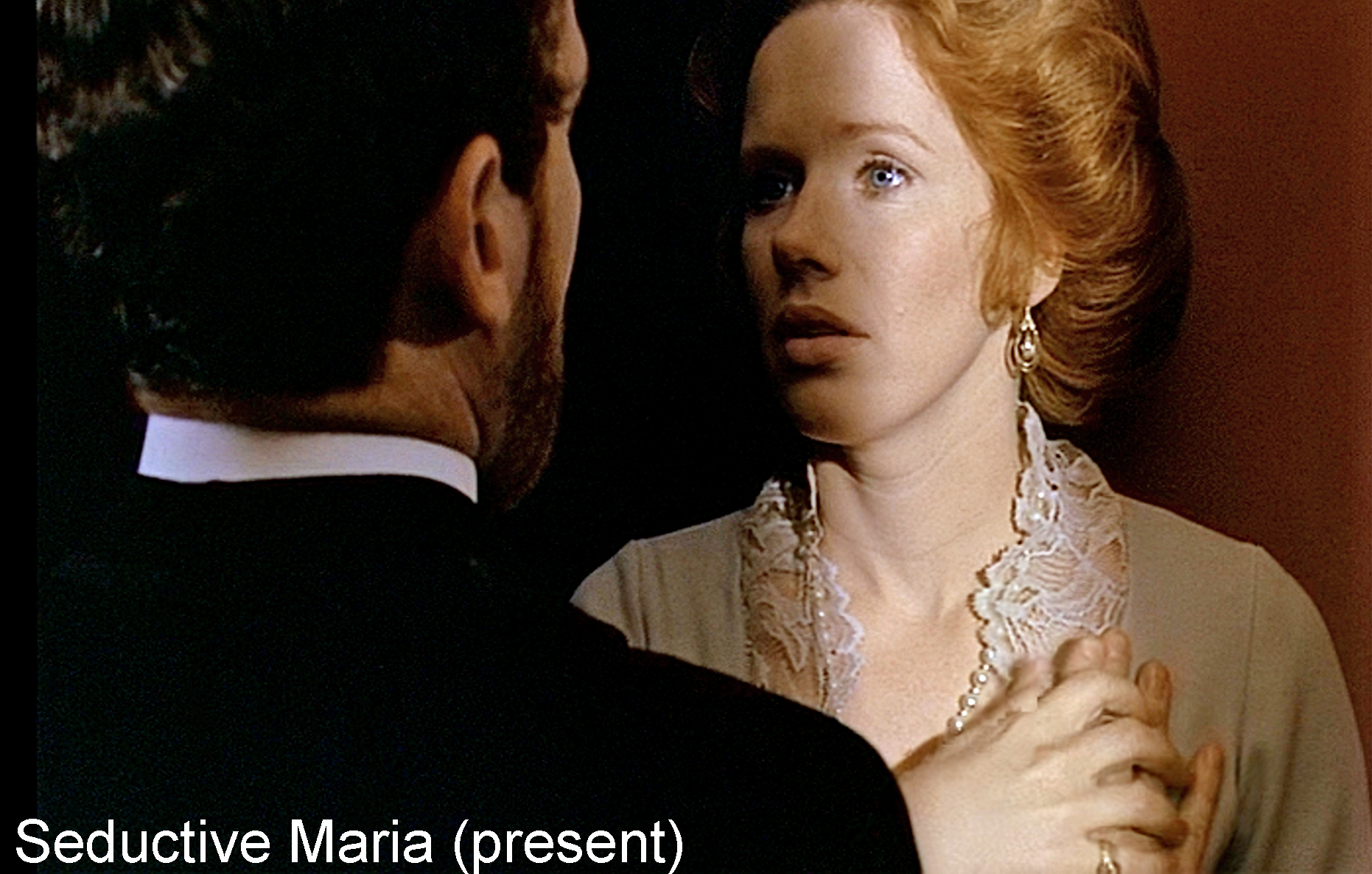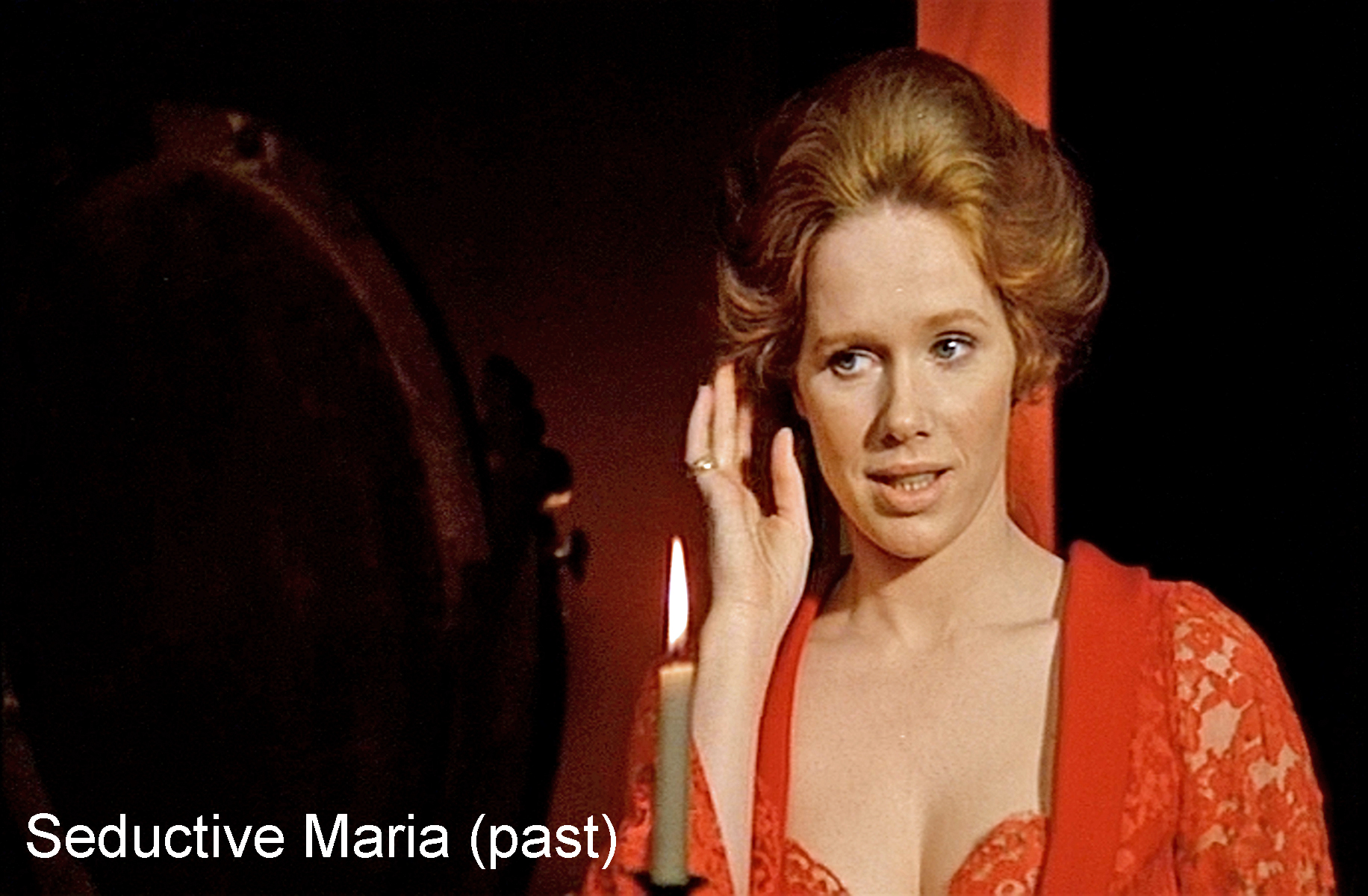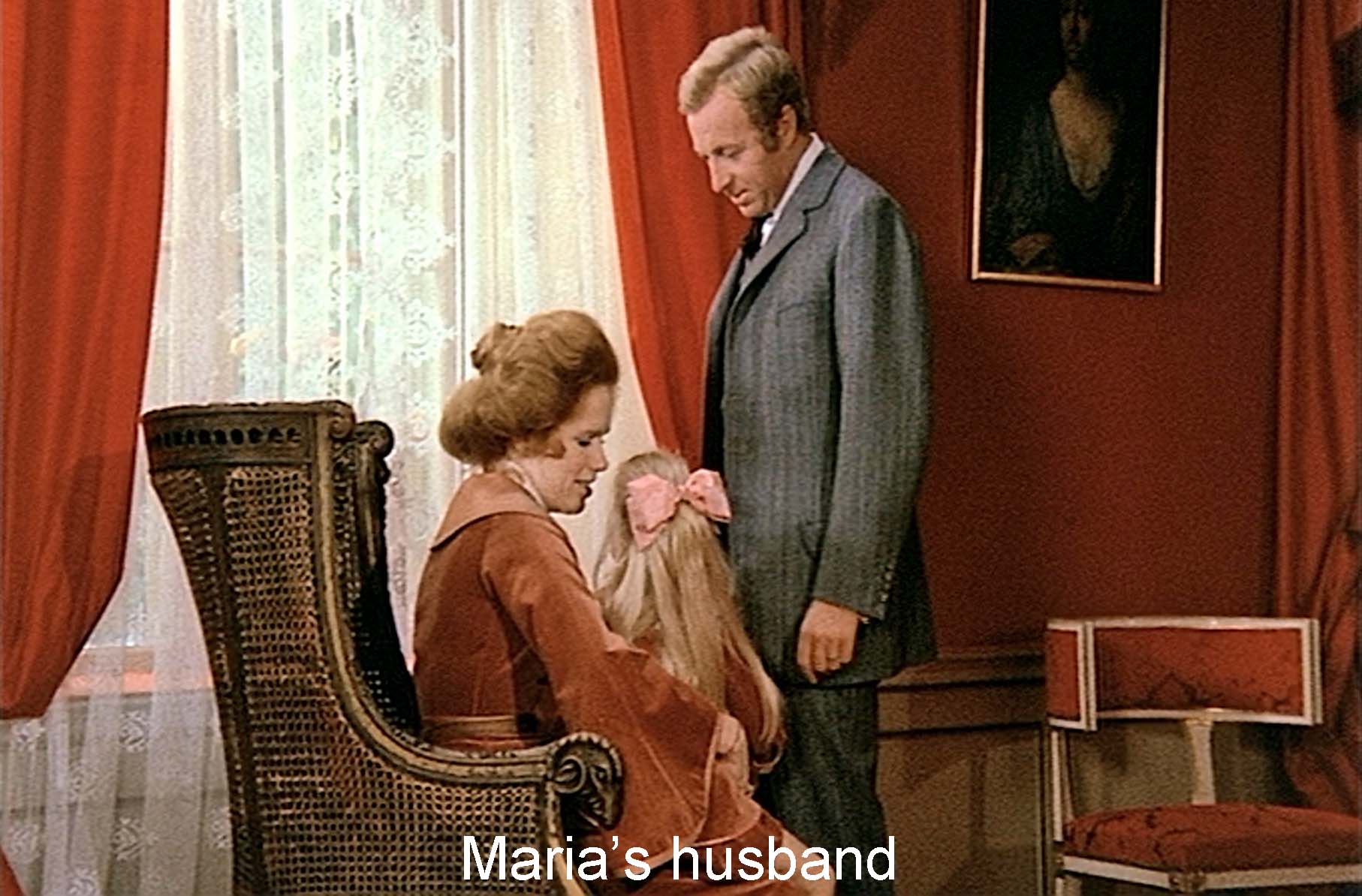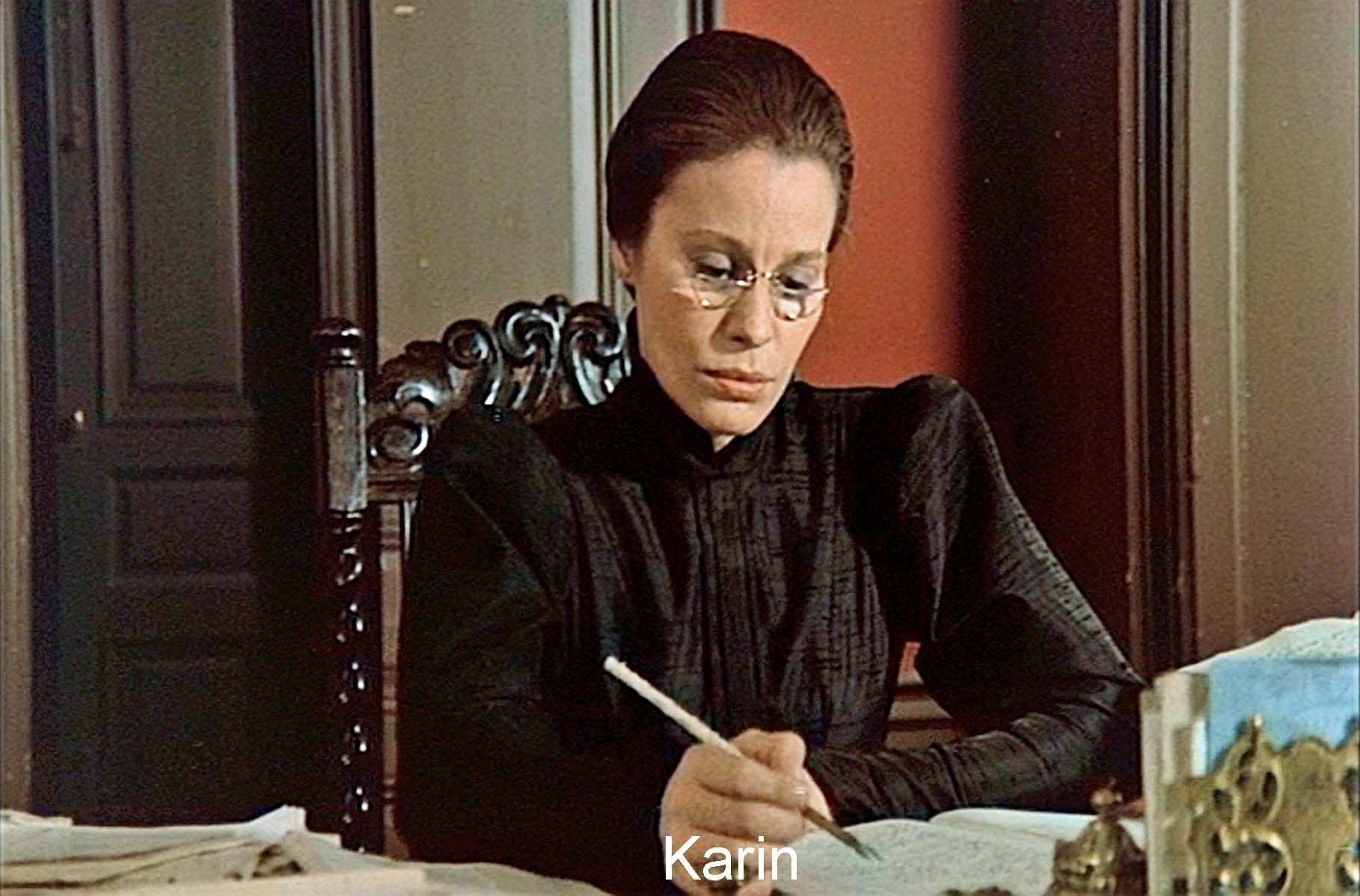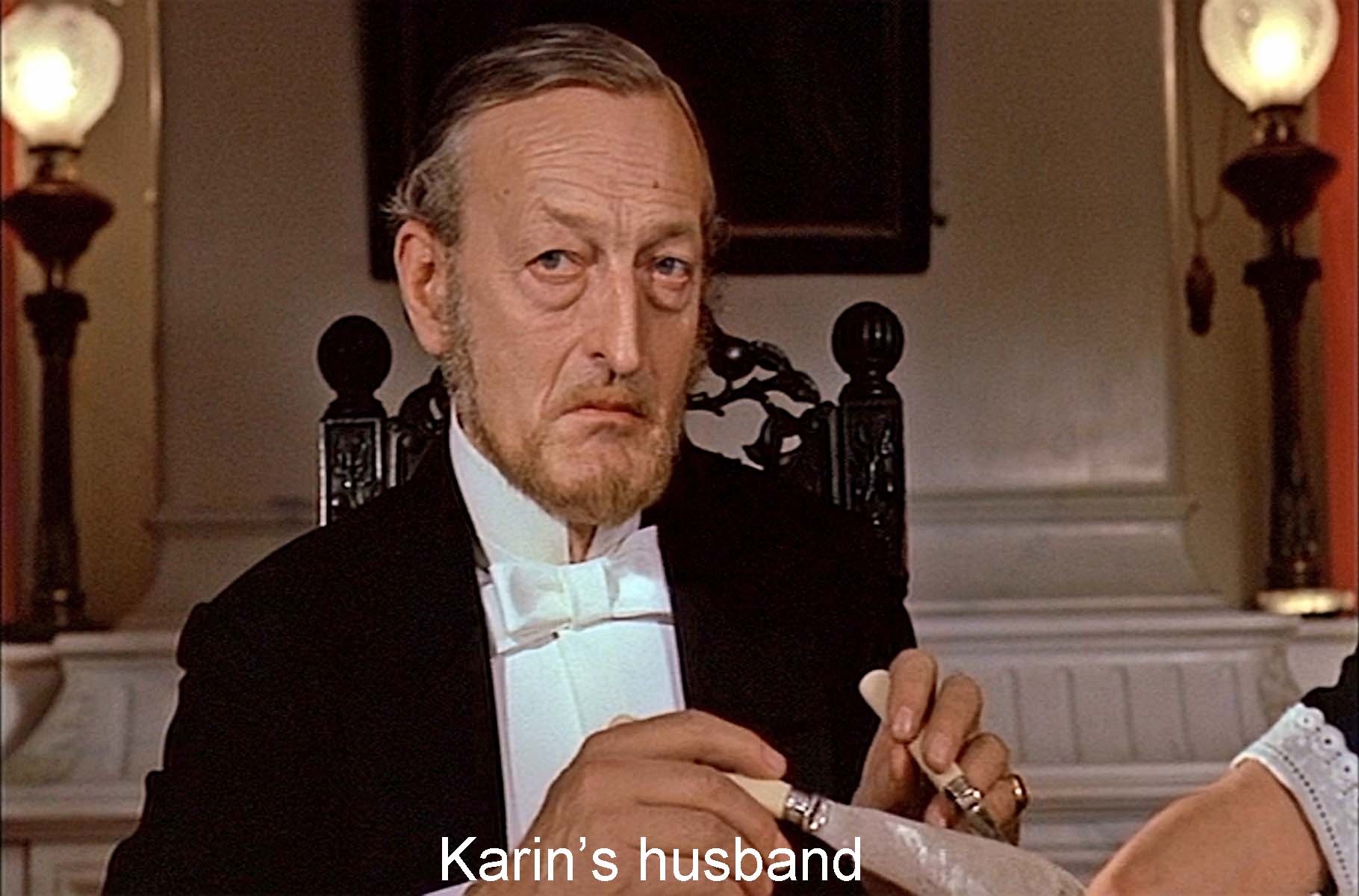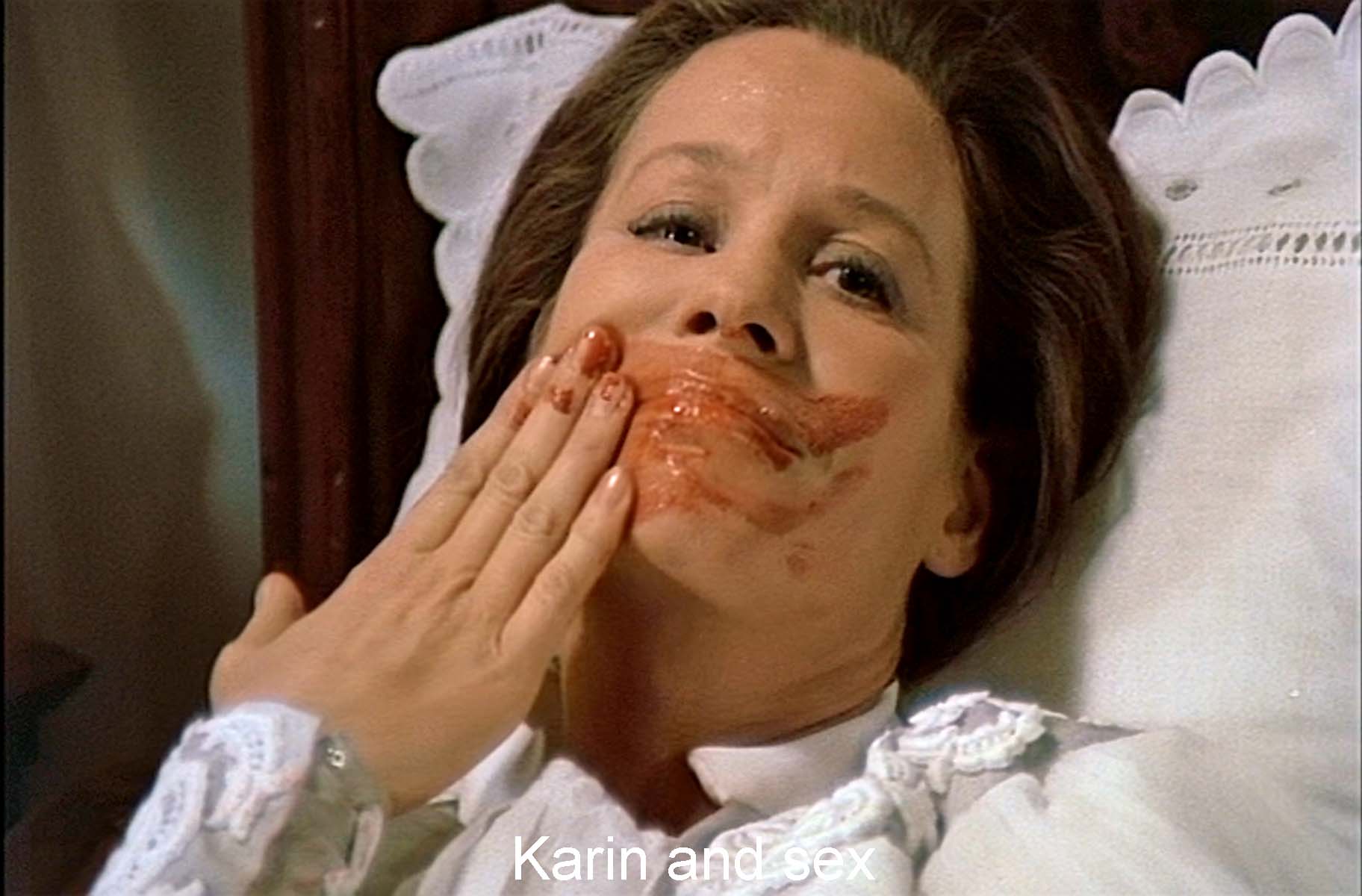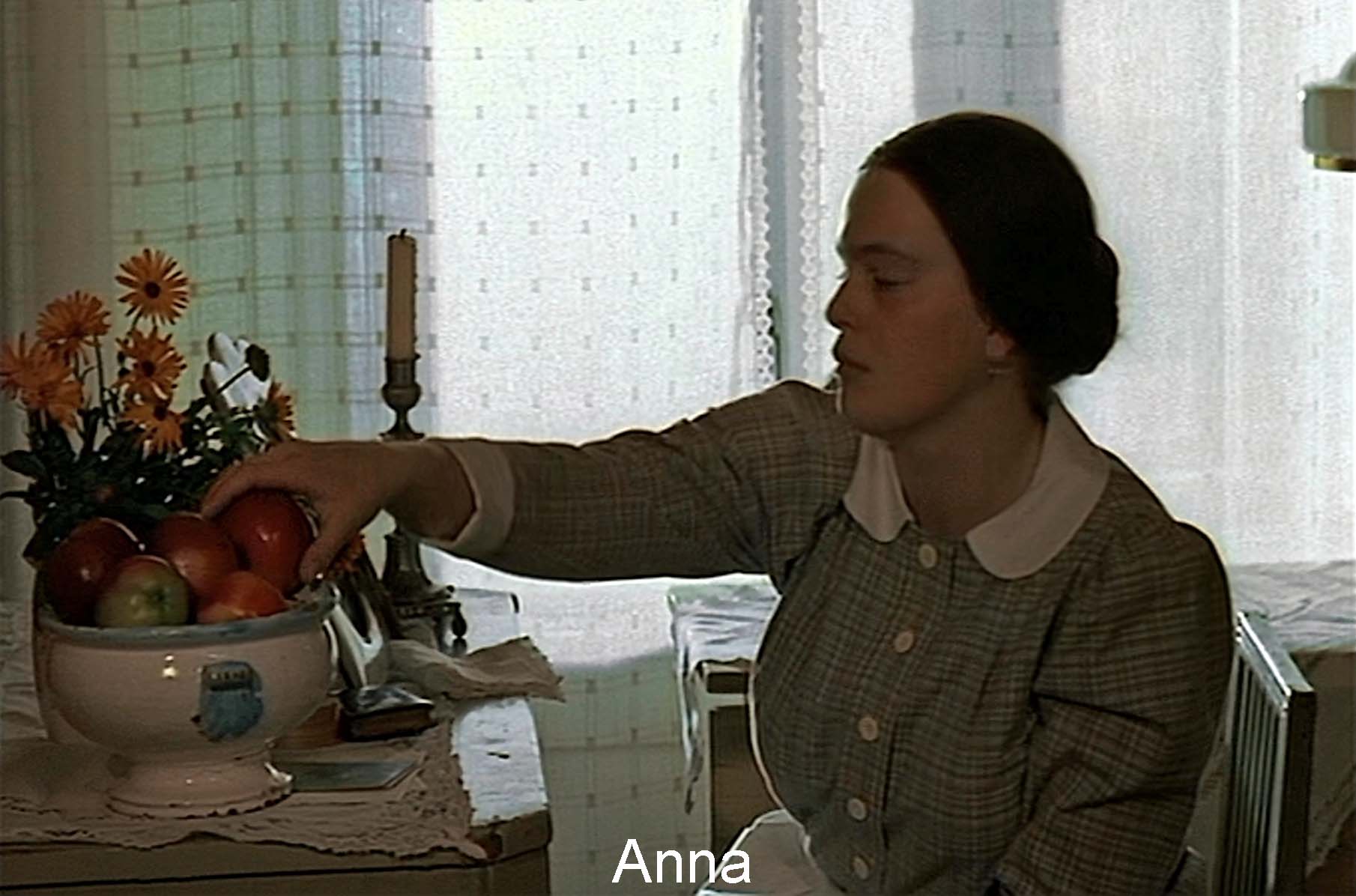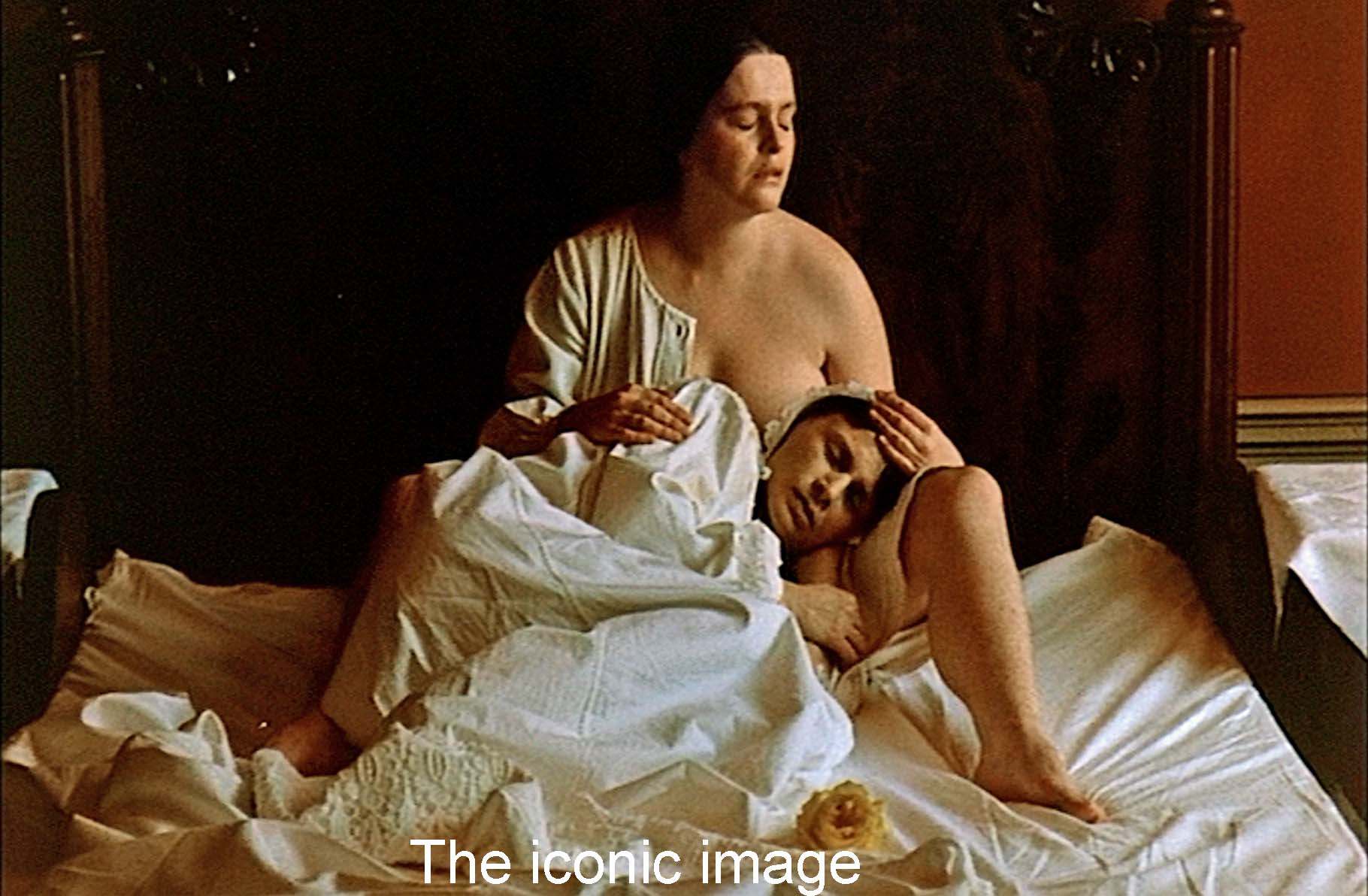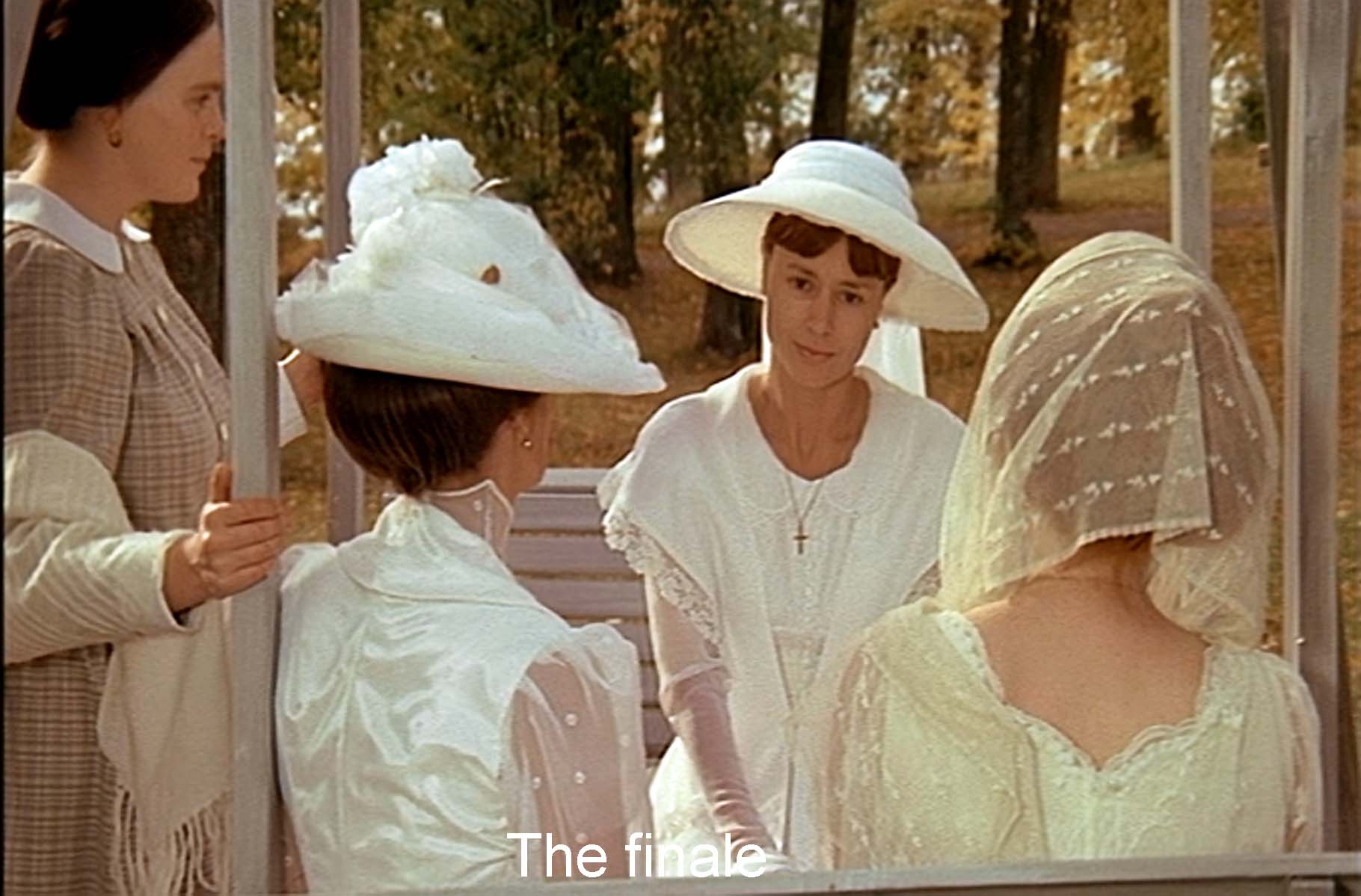Red—you can hardly miss it. It’s the first thing we see of this film (under the credits) and all through, wallpaper, blanket, upholstery—they’re all red. And then there’s blood. Critic after critic has dutifully quoted what Bergman wrote in one of his autobiographies, Images (1990):
All my films can be thought of in terms of black and white, except for Cries and Whispers. In the screenplay, it says that red represents for me the interior of the soul. When I was a child, I imagined the soul to be a dragon, a shadow floating in the air like blue smoke—a huge winged creature, half bird, half fish. But inside the dragon, everything was red.”
Frankly, I don’t find the idea of the insides of a dragon helpful. Better is what Bergman said in the screenplay itself:
. . . all our interiors are red, of various shades. Don’t ask me why it must be so, because I don’t know. I have puzzled over this myself and each explanation has seemed more comical than the last. The bluntest but also the most valid is probably that the whole thing is something internal and that ever since my childhood I have pictured the inside of the soul as a moist membrane in shades of red.
Who knows what the color of the “inside of the soul” may be? But we see red everywhere in Cries and Whispers. It is the first thing we see of this film, the red, the scarlet, really, under the credits. More importantly, Bergman brackets the various sequences of this film by cutting to a red screen (instead of the customary cut to black). These cuts signal that this or that sequence will be the memory of this or that character. Often the cuts bracket a brief close-up of the face of the character whose mind we are about to enter. Critic Bruce Kawin (in his book Mindscreen, 1978) has cleverly suggested that these cuts to red are cuts to “retinal red,” the color we see when we close our eyes against a bright light. This solid red makes the perfect image for the interior visions or memories from which Bergman created this film. We cannot tell, often, whether we are watching a memory or some current reality, and it doesn’t really matter in the flow of this film.
But Cries and Whispers doesn’t just use red. As Pauline Kael first noted, there are three colors in this film. Red, of course, but also the white of the nightgowns and sheets and dresses and black for the mourning clothes after Karin’s death and the men’s evening clothes throughout.
Red, white, and black, these are the colors of the moon. The rising moon is red, the full moon is white, and the new moon, invisible, is black. The moon has obvious associations with women’s menstrual cycles, and this particular combination of colors is associated with the moon or with mother-goddesses or the “triple goddess.”
Mythologists point to the somewhat puzzling occurrence in myth and legend of triads of women: the Gorgons, the Graces, the moirai (the Fates), the graiai (Old Age), the Norns, Macbeth’s “weird sisters,” and many another trio. Often, this female triad follows the pattern of the Fates, the first, Clotho, associated with birth, the second, Lachesis, with the course of life, the third, Atropos, with death. They represent life, in T. S. Eliot’s phrase, as “birth and copulation and death.” Sometimes the triad follows the related pattern of a virgin or spring goddess, a mother or harvest goddess, and finally a crone or death-goddess. We have, for example, springlike Persephone-the-creator in her six months on earth, Demeter the goddess of fertility and harvest, then Persephone-the-destroyer in her six months in Hades. Sometimes the triple goddess follows the pattern of first, virgin or unattainable love; second, the lush, sensual woman; third, the crone or old woman.
The triple goddess idea comes from nineteenth-century anthropology. I first encountered the triple goddess in Freud’s essay, “The Theme of the Three Caskets” (1913). He interpreted the three caskets in The Merchant of Venice and the three daughters in King Lear as these mythological aspects of woman. The triple goddess also became one of the Jungian archetypes. Poet Robert Graves popularized the triple goddess in books like The White Goddess (1948) and his exhaustive study The Greek Myths (1955). In that book he argued that a matriarchal religion preceded the patriarchal religion we all know. All the Greek myths arose, he claimed, as attempts to deal with the conflicts when the father-gods of patriarchy replaced the mother-goddesses of that earlier matriarchal religion.
Looked at mythologically, Cries and Whispers plays with the idea of these three sisters, their husbands and their housemaid as aspects of the triple goddess. Bergman could have encountered the concept in Freud’s writings or Graves’ or the Jungians’. Certainly the women in Cries and Whispers come close to the canonical pattern. Maria, lushly, sensually played by Liv Ullman, is the Venus or Aphrodite of the triad, the fruitful, sensuous mother-figure. Her red hair and red gowns are seductive—and she does seduce the doctor. It is she who recalls that beautiful doll’s house and the cozy family within. She has a child. But she is also cruel—to Karin and her husband. Karin (Ingrid Thulin, associated with black in the film) is both virginal and deadly (like Persephone-the-destroyer). “Don’t touch me.” “I don’t like to be touched.” She mutilates herself to fend off her nasty husband, but the act is also a pretend defloration—or menstruation—that might repel him. (There is a recurring image of red wine in a wine glass.)
Agnes (Harriet Andersson) is always associated with white sheets and red blanket. She surely represents death and dying. Yet it is she whose diary entry records the family intimacy of the finale. These things, though, are past and gone—dead. Plump, bosomy, nurturing Anna (Kari Sylwan) is a better mother than Maria. She is lower-class, while the faulty women are upper-class. It is she, the docile, obedient one who prays and eats the apple, piously accepting mortality. It is she who provides the iconic image for this film. Bare-breasted, she holds Agnes in her lap in an image that recalls Michelangelo’s Pietà. Yet the two she mothers, her daughter and Agnes, both die. Then there is the mother of these three girls (seen in flashback, also played by Liv Ullman). She suffers, apparently, from loneliness and boredom—this Venus has no Adonis.
The names of these five women have rich mythological overtones. Agnes: the sacrificial lamb (Lat. agnus). Mary: the mother. Karin: a version of Greek kore, the virgin goddesses, shown in Greek statuary with a smile shaped like the crescent moon. And Anna, the mother of Mary, a super-mother, as it were.
They correspond somewhat to the canonical triple goddess of Graves or Freud but inexactly. Bergman himself and many critics have simply suggested that this is a movie about different aspects of the Mother or Woman (in that capitalized, abstract way). And perhaps we should settle for that. Despite the inexactness, though, to my mind, the omnipresent red, white, and black argue for a closer correspondence to the mythological triads of female goddesses.
As one would expect, men in this movie about Woman are contemptible. Maria’s husband is the cuckolded Joakim (Henning Moritzen), unable even to commit suicide successfully. Then there is Karin’s husband, the “diplomat,” the mean and nasty Fredrik (Georg Årlin), humiliated and repelled by Karin’s self-mutilation. Erland Josephson, one of Bergman’s favorite actors, plays David, the weak-willed, philandering doctor. Despite his misgivings, he succumbs to Maria’s seductive charms. Finally, there is the priest (Anders Ek) who pronounces a skeptic’s eulogy over the dead Karin. Men in this movie merely consume: they want sex; they eat. We see all three of the men eating vigorously. By contrast, the women pick at their food, spill wine, or peel a pear without eating it. Men are the consumers, women what they consume—or try to. Women are the powerful ones. The two “bad” women in the movie have men. The two “good” women have none.
Capitalized Woman is not the only theme shaping Cries and Whispers, however. As always the opening and closing shots are key. Bergman opens the film with a shot of this manor’s park in the early morning, and the very first image is a stone statue of a mythological figure (Orpheus?) holding a lyre. Music—but stilled, while on the soundtrack the hours chime. Time, but the visual is misty and motionless until he cuts to the house and its clocks. He alternates shots between the ticking of time and the ornamental figures decorating the clocks, between movement and the figures, frozen like that opening lyrist. Time and non-time, then, form a second theme Bergman plays with in Cries and Whispers, and time links closely with the inconstant moon or the stages of a life (as emblematized by the triple goddess).
Balancing that opening is the closing, a scene taken from Agnes’ diary as read by Anna—this would be their shared memory. We see the three sisters, now all in white, and Anna, strolling together in the park of the opening shot. They go to a swing and Anna pushes them gently back and forth. Agnes comments (in her diary, read by Anna):
We sat in [the swing] like three good little sisters and Anna pushed us, slowly and gently. All my aches and pains were gone. The people I am most fond of in all the world were with me. I could hear their chatting around me. I could feel the presence of their bodies, the warmth of their hands. I wanted to hold the moment fast and thought, “Come what may, this is happiness. I cannot wish for anything better. Now, for a few minutes, I can experience perfection. And I feel profoundly grateful to my life, which gives me so much.”
Movement as opposed to the deathly stillness of the opening, and white, as opposed to the interior red of the opening, and an outdoors scene, like the opening, but bright and full of joy and intimacy. But only a moment. Near the end of the film, in some sort of dream or hallucination, Agnes, dead, calls on her sisters to hold her hands and warm them. No way! They recoil in horror. Now, this text about perfection, so different from the tangled hatreds and meannesses of the body of the film, ends it.
The film ends with a single sentence in Swedish against a red background: Så tystnar viskningarna och ropen. “And so the whispers and shouts go quiet.” That calls for a word about translation. The Swedish title of this movie is Viskningar och rop, literally, whispers and shouts—that is rop’s one meaning. The English word “cries” has two meanings: shout or weep, and “cries” makes a more poetic translation, but introduces an idea not present in the Swedish title.
With the proper title, another theme emerges: whispers, shouts--speech and words. They work out badly in this film. The doctor lies to Agnes. Then, in Maria's memory, she speaks seductively to him, culminating in her husband's attempt to kill himself. Frederik always speaks coldly. In the final discussion of what to do about Anna, both sisters and their husbands speak meanly. Sado-masochistic Karin speaks--and shouts--hatefully to one and all. Maria uses words to win intimacy from Karin, but then rejects her with empty words in the departure scene. The priest unloads his unbelief on the mourners. Again and again, the sound track carries the vague sound of incomprehensible whispers.
The opposite to words and speech is touch, and touch here connotes human warmth and intimacy. That's exactly what Karin refuses in her “I don't want to be touched.” By contrast we see Agnes eagerly clutch the doctor's hand. Repeatedly, the characters place a hand gently against a cheek. The one time the sisters seem decently human, they bathe Agnes, give her a new nightgown, stroke her hair. Later, in Anna's dream, the dead Agnes cries out for touch, for someone to warm her hands. Her sisters recoil, but Anna holds her close to her own fleshy bosom--for the second time. (The doctor's stroking Maria's breast parodies this nurturing touch.) In the final soliloquy, Agnes says, “ I could feel the presence of their bodies, the warmth of their hands.” In an earlier reading from her diary this kind of intimacy is “grace,” adding a religious note. These positive passages, notice, come from Anna's diary--written words, not speech.
Truly, then, at the end, both the whispers and the shouts go silent. Language proves inadequate, as in other Bergman films like Though a Glass Darkly (1961), The Silence (1963), or Autumn Sonata (1978).
This is a movie, as I see it, about words, adequate and inadequate, and Woman (in that capitalized and abstract sense), mortal, time-bound, needing the touch of flesh, and nurturing. As a psychological critic, I cannot help reading Ingmar Bergman’s psyche into this movie. He is, after all, one of the most autobiographical of moviemakers. I’d suggest that this is a movie by a man who feels toward women in deeply conflicted ways. Woman as a sickly, dying thing, dying from some unknown disease in her “plumbing” (Agnes). Woman as sexual and seductive (Maria). Woman as grasping and hostile (Karin). Woman as mysterious and unapproachable (their mother). But finally Woman as the completely and utterly giving mother (Anna), and Bergman has spoken of how, as a boy, he was overwhelmingly in love with his mother. Our human flesh needs touch and intimacy, what we get, or should get, from a mother--Woman. Shouts and whispers, speech in general, fails by comparison.
At the deepest level—and I think this tension runs all through Bergman’s work— you could say that Cries and Whispers is about the tension between these mythological (or symbolic or allegorical or theological or surreal) themes and the intensely personal characters that people this like his other films.
Bergman is notorious for centering his films on theological and other abstract themes. Think of Seventh Seal, Smiles of a Summer Night, or The Silence. (I suspect this thematic emphasis has led to his downgrading in the minds of the critics and professors who establish the canon of “great” films and who, these days, no longer favor such a thematic centering—or Bergman.)
Yet Bergman is equally renowned for the intensity of his portrayals of human beings—think of Persona, Scenes from a Marriage, Wild Strawberries, or this movie. Bergman creates the personal and emotional intensity by his relentless concentration on faces in extreme close-up. Indeed he titled one of his films just that, Ansiktet, face.
It is this rich tension between the highly particular and the highly abstract, I think, that makes Bergman, whatever the current cognoscenti may say, one of film’s half-dozen greatest-ever directors.
